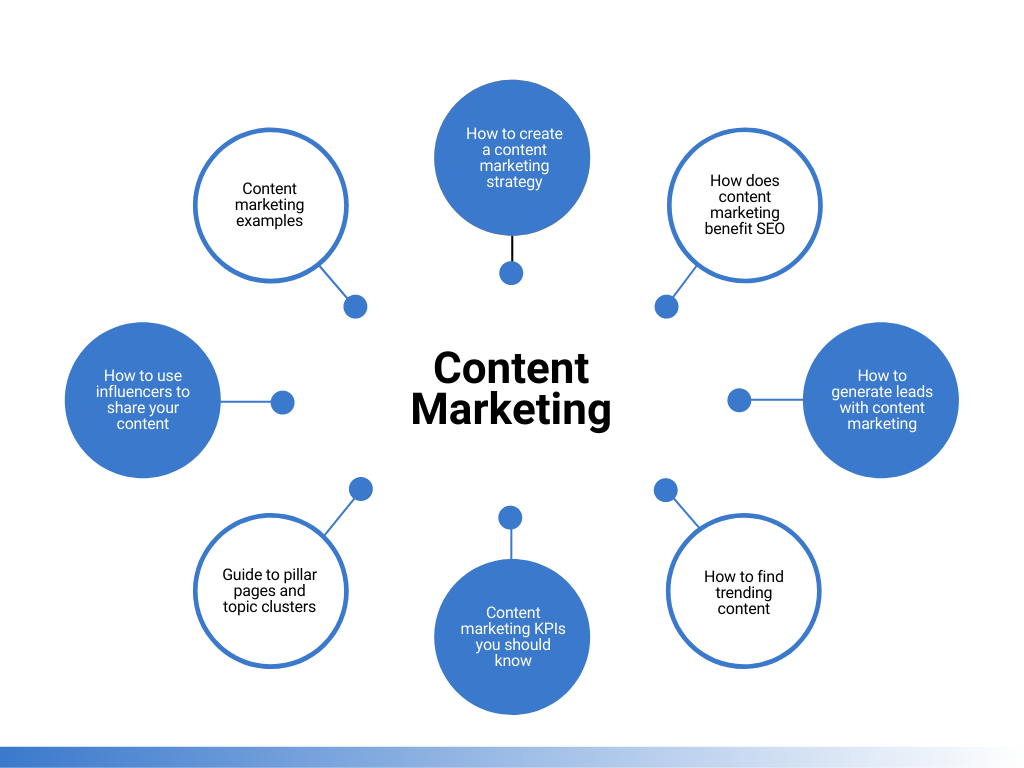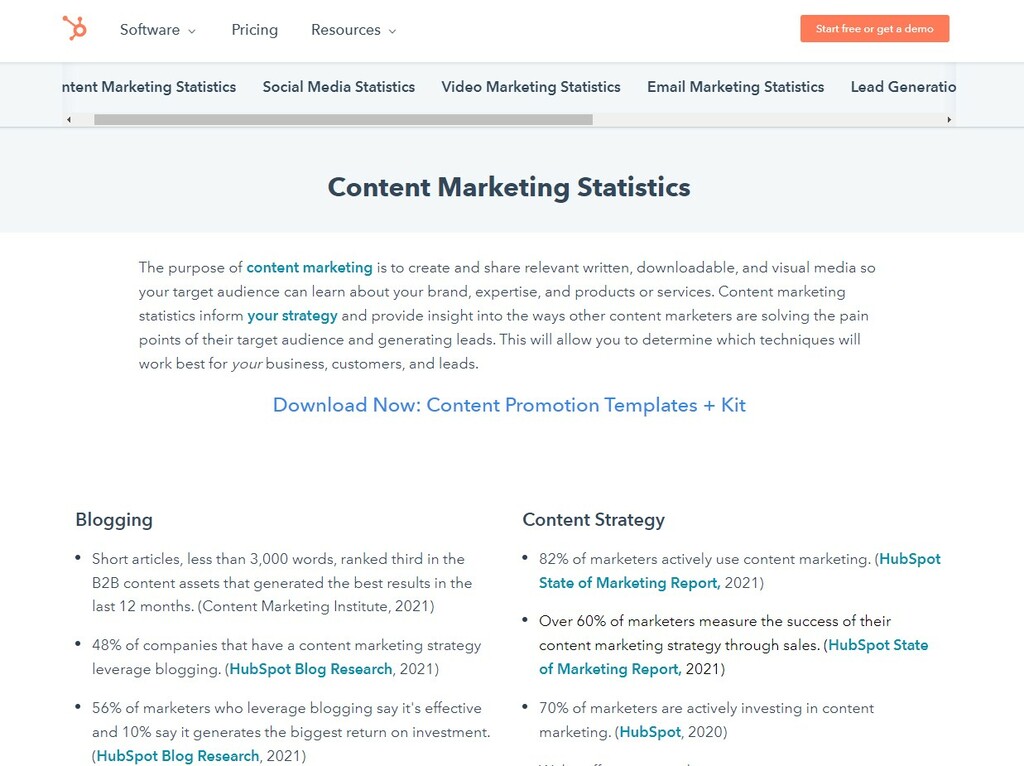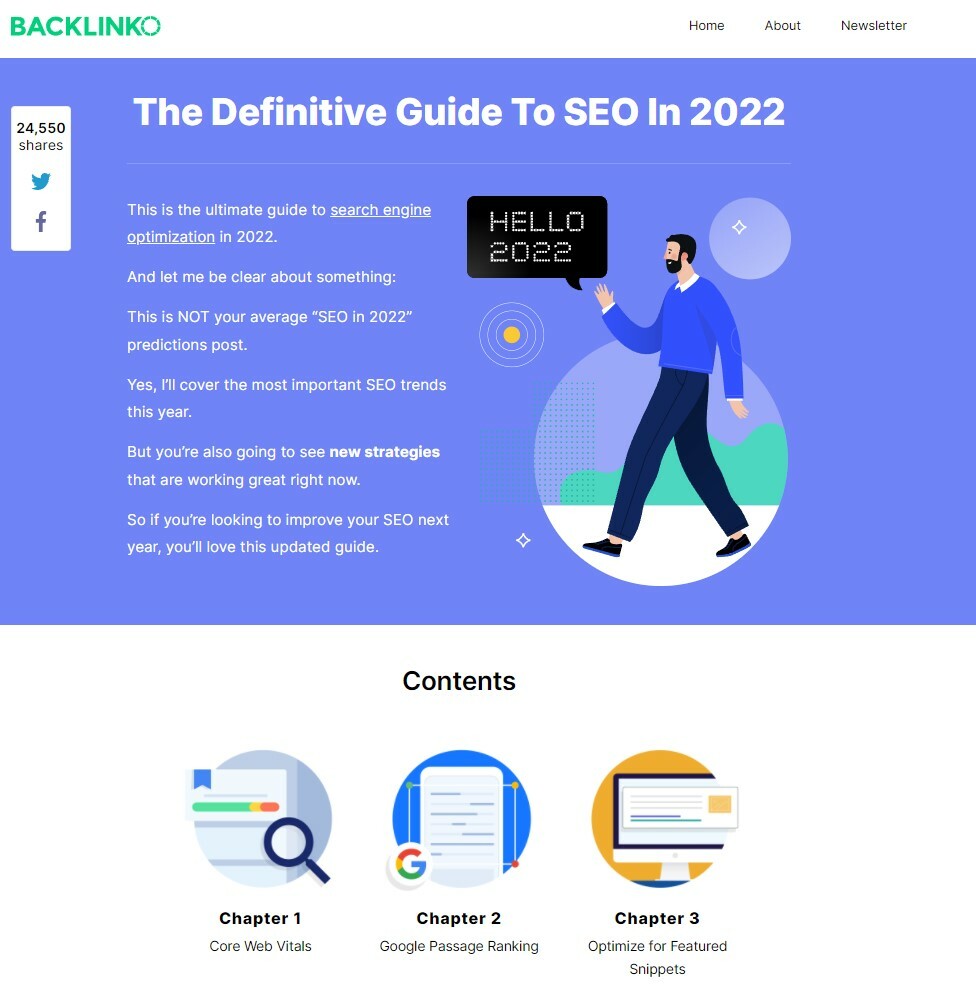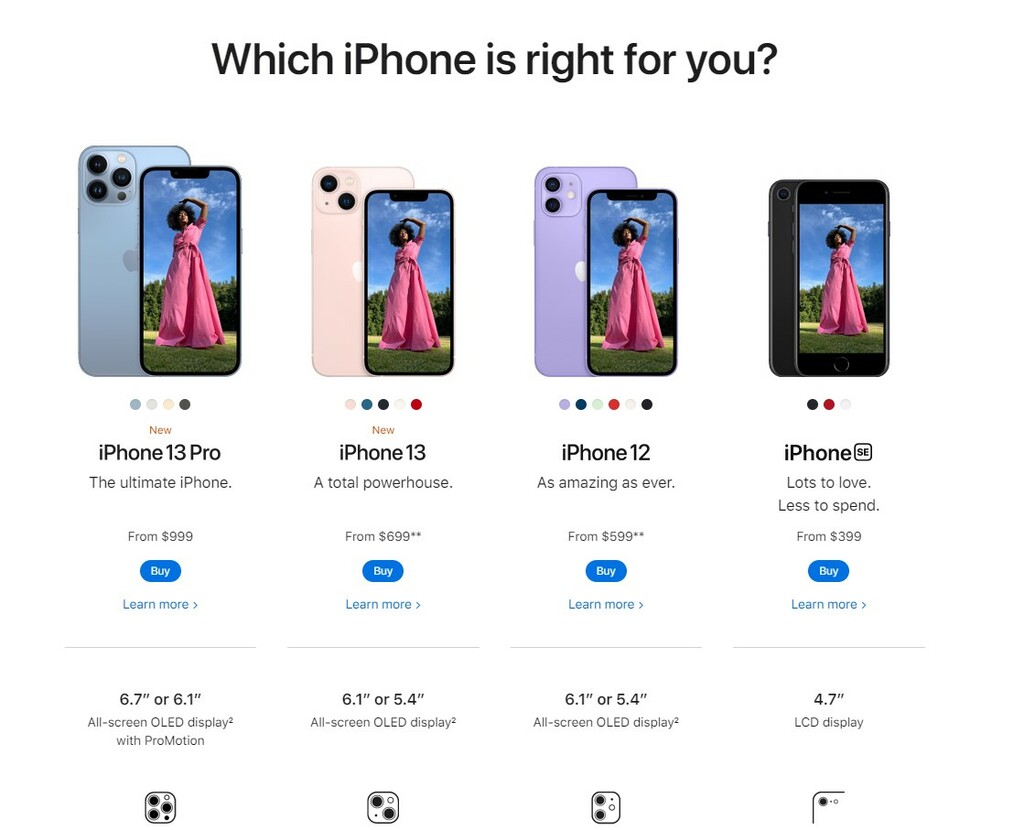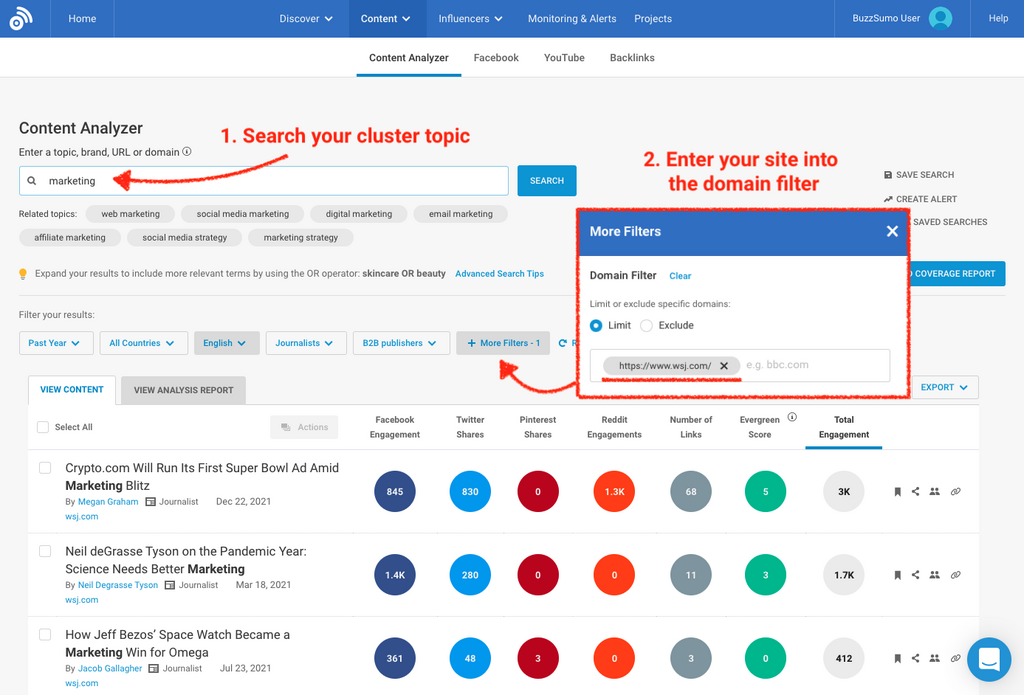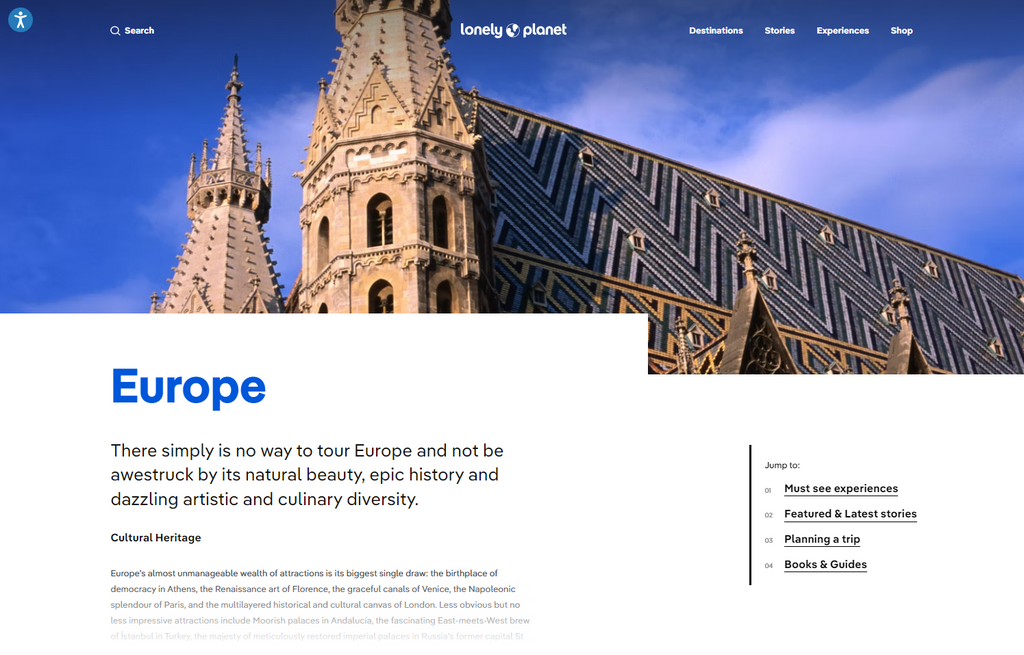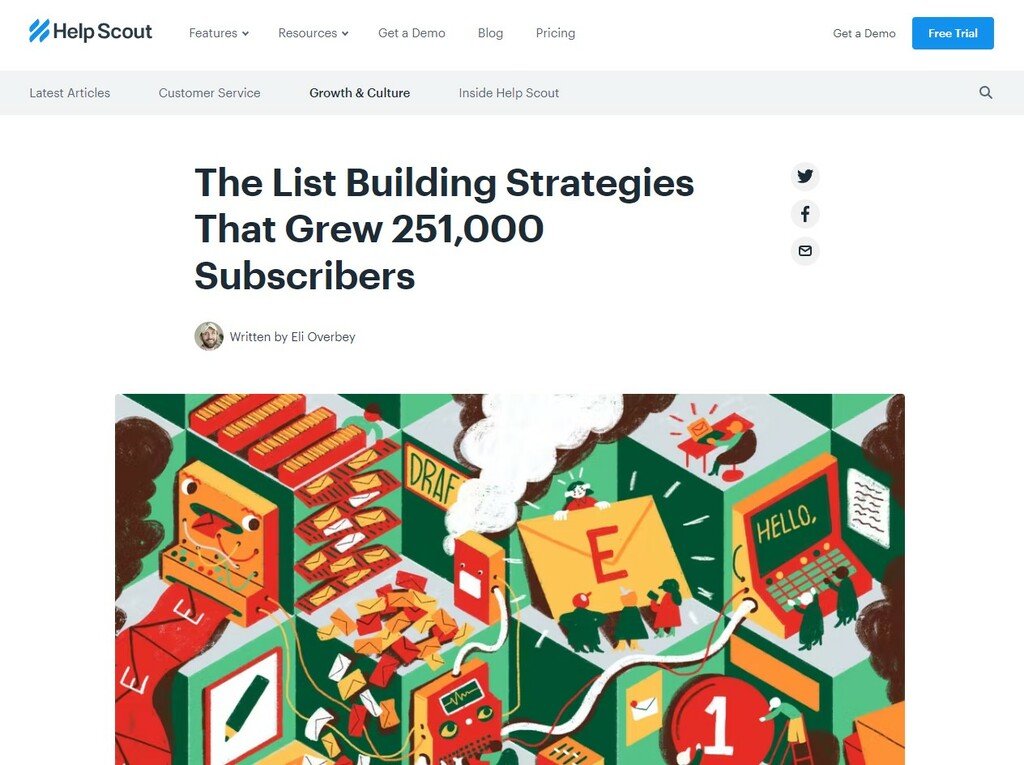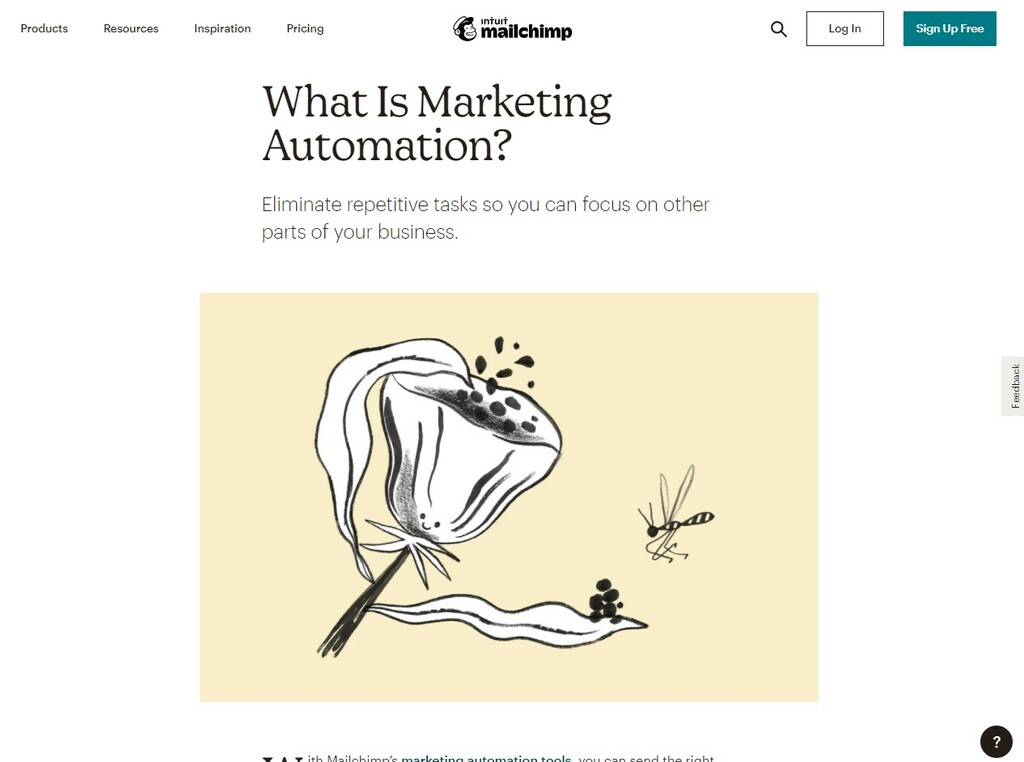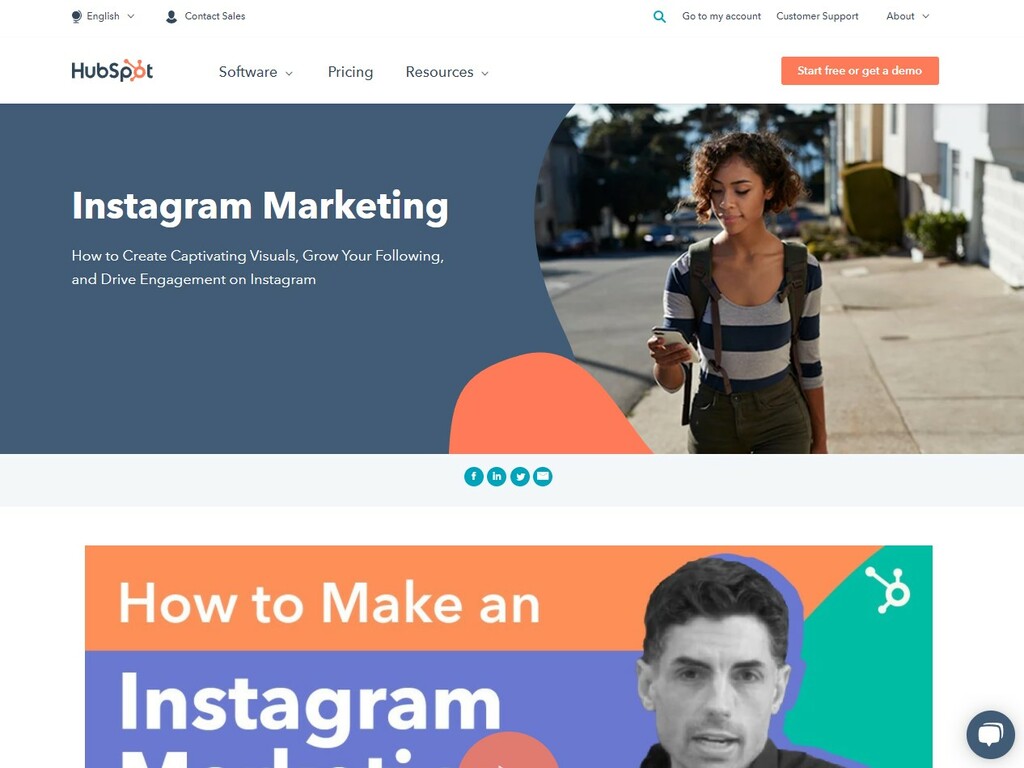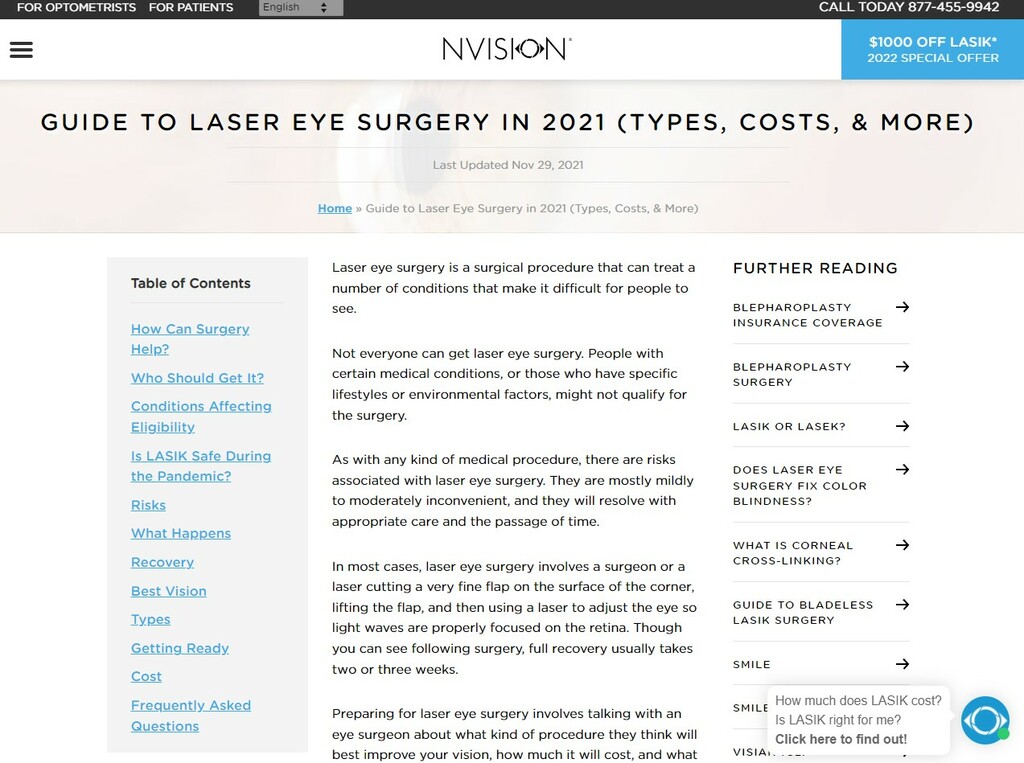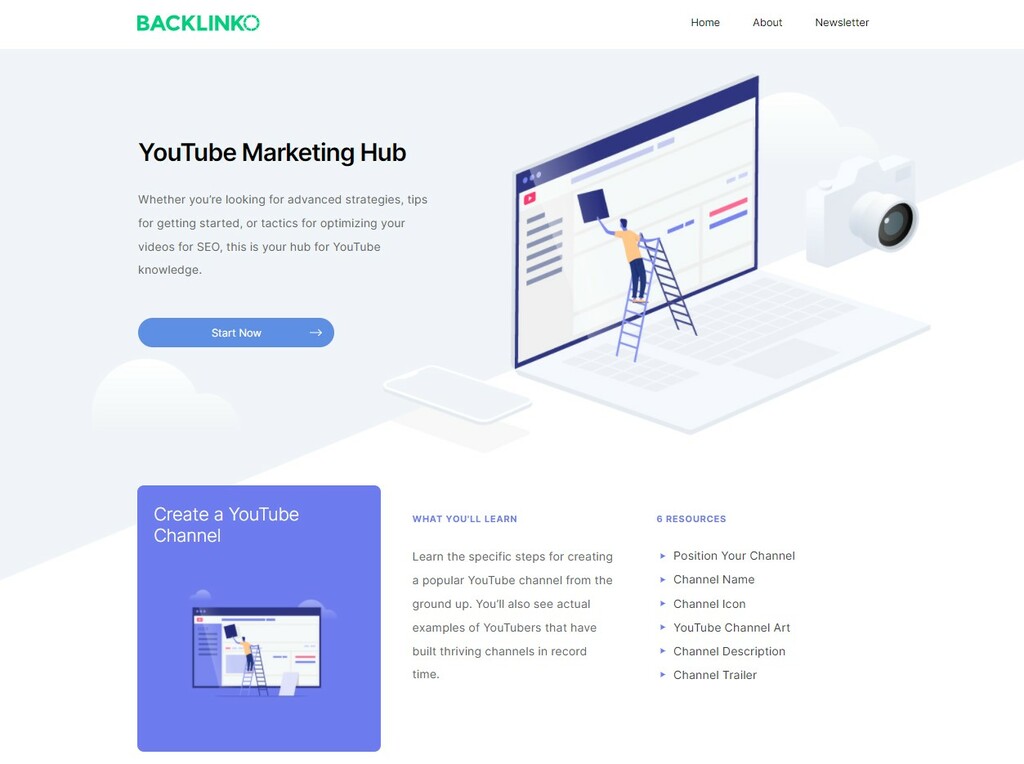Pillar pages and topic clusters are a content strategy that work for any niche or industry. Supported by site architecture and SEO best practices, this strategy is perfect for brands seeking to grow their website traffic and engagement.
What are pillar pages?
A pillar page is a page on a website that explores a topic broadly (yet comprehensively), and is then supported by a cluster of other pages through internal links. These pages, called topic clusters, contain subtopics related to the pillar page.
For example, if a website’s pillar page is about content marketing, the supporting pages will cover topics such as “does my website need a blog?” or “how to find content ideas”.
Pillar pages differ from landing pages in that they contain navigation and more text. A landing page is designed with a high conversion rate in mind, which dictates its design, copy, and highlighted CTAs. Whereas a pillar page is often designed to be an educational or informative tool.
Types of pillar pages
Resource pillar page
This pillar page serves as an educational tool around a specific topic. It can take the form of an ultimate guide, what-is, and how-to structure that contains internal links to its supporting cluster.
The resource pillar page can also be a collection of externally collected resources with supporting information to help the reader make an informed decision around a topic. For example, 25 digital marketing tools every marketer should know or 100 content marketing statistics.
10x content pillar page
The 10x pillar page has a specific strategy; be 10 times better than anything else out there.
This page should have unique elements to help it outshine the competition in the form of interactive content or original research. The cluster supporting the 10x content pillar page can come in many forms (blog posts, ebooks, YouTube videos, etc.).
The 10x content pillar page can also serve as a lead generator when paired with a content upgrade – ie. downloadable templates.
Service or product pillar page
A service pillar page provides an overview of an organization’s services.
Marketing agencies use service pillar pages to showcase their range of services, which can link to articles that then discuss those individual services at length.
SaaS companies benefit from blending resource and product pillar pages through ultimate guides that actively promote and educate the reader about their software.
A product pillar page can function similarly to the service page, showcasing:
- all products available
- category pages of an ecommerce website
- single products
A great example of a single product pillar page is Apple’s iPhone page.
Product and service pillar pages can serve as the first point of contact with potential customers. Create these pages with that in mind. Offer a tasting menu of your best products, features, or services.
Elements of a successful pillar page
Even if there is no one way to build a pillar page, there are some best practices to help make it more successful. The following elements will help your pillar page to be more engaging.
Digestible - Present the information in multiple ways while avoiding walls of text.
Shareable - Your audience is looking to share useful information, to raise their own profile. Give them something to talk about.
Original research - original research will help you stand out from the crowd by presenting a new story. It is also a great strategy for getting backlinks.
User-friendly - Core Web Vitals are going nowhere. Make sure the page loads quickly and is easy to navigate. Remember to check it on desktop and mobile!
Concise - Avoid the 10k word guides. A pillar page is an overview of a topic so aim for around 2000 words.
Interactive - Break up the page with videos, quizes, sliders, or other interactive elements.
Table of contents - Help website visitors navigate your pillar page easier by providing a table of contents with jump links.
CTA - It doesn’t need to be a sales one. Lead your reader through your cluster by linking to more content, or a free trial.
What are topic clusters?
Topic clusters are the pages that support your pillar page. They target secondary keywords and long-tail keyword subtopics at length.
Topic clusters are subtopics that are strong enough to stand on their own (i.e. blog post, video, etc.), but have a common connection with the pillar topic, and can be clustered together with other subtopic content to help tell a story.
Connecting these pages provides a positive experience for website visitors, as they’re easily able to find the similar-themed content they’re looking for – and what pleases users, pleases Google! Making this an extremely valuable strategy from a search engine perspective.
Search engine bots crawl through content like a human reads it, and recognizes the connections between all of these similarly themed pages.
How to identify topics for cluster content
Choosing a topic for your pillar page should come fairly easy, as it should correspond to your business niche, but how do you identify topics for supporting cluster content? And how many pieces of content do you need to form a cluster?
Do a content audit
The first step you’ll need to take is to audit your existing content. This will help you identify the pages that can potentially support your pillar page.
You can audit your content easily in BuzzSumo, with a domain search in the Content Analyzer.
This will give you a top-level overview of your published content, so you can work out how to categorize it.
If you have cluster categories already in mind, you can also see what content you've already published on that topic.
For example, imagine you work for Wall Street Journal, and want to create cluster content around the topic of "Marketing".
All you’d need to do is search the keyword “Marketing”, and add a domain filter to find all of the existing content published by the WSJ around that topic.
Then simply rinse + repeat that strategy for your other topic clusters.
You can get ideas for topic clusters in a bunch of other ways in BuzzSumo.
- Enter your pillar page keyword in the Keyword Tool and browse related or similar, high volume keywords for cluster content ideas.
- Enter your pillar page topic into the Content Idea Generator and subtopics from trending content, customer questions, and SERP data.
- Discover the most popular social media topics related to your pillar page, in the Topic Explorer.
- Get ideas from your competitors’ content, and validate your topic cluster ideas with engagement trend data, in the Content Analyzer.
From your research, try to identify at least five subtopics that can support your pillar.
Consider the marketing funnel, and try to choose topics that will satisfy each step of the customer journey, or different types of search intent.
How many cluster pages should link to a pillar page?
There's no hard and fast rule for how many pieces of content can link to a pillar page. In the examples later on in this blog, some pages have over 200 internal links, while others have less than 60.
The pillar and cluster content strategy is meant to support website visitors from start to finish in their journey for information. This is an opportunity to build trust and value while nurturing a potential lead.
How to set up pillar pages and cluster content
Pillar pages are intended to be top-level navigation pages. If you remember in the types of pillar pages, many of them are naturally top-level (category page, service page).
But, this doesn’t mean that it is absolutely necessary.
Pillar pages can be:
- A stand-alone page
- A subcategory page
- Or even a blog post
What’s important is that it can be found. The single most important aspect to a pillar page and cluster content strategy is internal links.
Don’t forget to provide internal links within the content (when relevant) to all supporting pages, posts, videos, etc.
Overthink Group illustrates the different ways to organize pillar pages and cluster content which are more realistic in practice.
SEO benefits of a pillar page and topic cluster strategy
Improves site architecture
Pillar pages create a hierarchical structure around a specific topic while improving internal links. This is a great signal to search engines that you are an authority on the topic.
Satisfy search intent
Because pillar pages are typically informative, they help answer queries that are questions. If the pillar page and clusters are built to answer all possible questions around a topic, then the reader should be satisfied with the content. Of course, don’t forget to make it engaging and original!
Long read time
Because your pillar pages are long (at least 2000 words) and have a strong internal linking structure, this helps to increase the average time on page, and even the number of pages a visitor is viewing.
Authority
The structure of pillar pages and topic clusters signals to search engines that your website is an authority on a topic. This strategy also helps to satisfy E-A-T for Google.
Increased engagement
A user-friendly pillar page that is easy to navigate and matches user intent will naturally increase engagement for that page.
Rank for high volume (broad) keywords
If you create one piece of content around the keyword “content marketing” it will be incredibly difficult to rank. If you create a pillar page around “content marketing” that is linked out to a wealth of information around this topic, then your chances increase to rank for these difficult high volume keywords.
More backlinks
Due to the nature of pillar pages, they’re a natural fit for backlinks, and who doesn’t want more backlinks?
10 real pillar page examples we love 💙
1. Lonely Planet: Europe
- 🔗 Backlinks: 23.8k
- 🔑 Keywords: 3k+
- 📢 Total engagement: 1.5k
- 🌲 Evergreen score: 10
- 🏠 🔗 Internal links: 96
- 🏞️ 🔗 External links: 0
- 🏛️ Type of pillar: Service/Product
- 💡 Why it works: Concise and compelling introduction with jump links at the top for navigation. It presents all of their content around Europe in several ways so you can explore the content through whatever inspires you.
2. Help Scout: List building strategies
- 🔗 Backlinks: 395
- 🔑 Keywords: 471
- 📢 Total engagement: 48
- 🌲 Evergreen score: 3
- 🏠 🔗 Internal links: 61
- 🏞️ 🔗 External links: 53
- 🏛️ Type of pillar: 10x Content
- 💡 Why it works: Comprehensive guide with user-friendly navigation. This pillar page doesn’t just link out to their own content, but also other prominent names in the industry. While its backlinks and keywords are small compared to the other pages, they are ranked #1 for their target keyword.
3. SearchEngineJournal: What is SEO?
- 🔗 Backlinks: 30.4k
- 🔑 Keywords: 20.3k
- 📢 Total engagement: 5.5k
- 🌲 Evergreen score: 234
- 🏠 🔗 Internal links: 67
- 🏞️ 🔗 External links: 44
- 🏛️ Type of pillar: 10x Content
- 💡 Why it works: A top-level navigation guide that gives a broad overview of SEO. It’s also part of a sequential learning series, and provides links to other SEO content found on the site.
4. MailChimp: What is marketing automation?
- 🔗 Backlinks: 1.51k
- 🔑 Keywords: 185
- 📢 Total engagement: 37
- 🌲 Evergreen score: 26
- 🏠 🔗 Internal links: 218
- 🏞️ 🔗 External links: 21
- 🏛️ Type of pillar: 10x Content
- 💡 Why it works: Very easy to digest, content is broken up with videos, testimonials, and articles that go in-depth around marketing automation, and connect their marketing automation features as solutions to common issues.
5. HubSpot: Instagram marketing: the ultimate guide
- 🔗 Backlinks: 7.5k
- 🔑 Keywords: 12.9k
- 📢 Total engagement: 759
- 🌲 Evergreen score: 45
- 🏠 🔗 Internal links: 100
- 🏞️ 🔗 External links: 142
- 🏛️ Type of pillar: 10x Content
- 💡 Why it works: The content is organized in a really easy-to-read format, and a lot of real-world examples are provided to support the content.
6. NVISIONCenters: Guide to laser eye surgery
- 🔗 Backlinks: 555
- 🔑 Keywords: 3.4k
- 📢 Total engagement: 26
- 🌲 Evergreen score: 0
- 🏠 🔗 Internal links: 162
- 🏞️ 🔗 External links: 22
- 🏛️ Type of pillar: Service/Product
- 💡 Why it works: This pillar and cluster strategy contains more than 248 pages of content that discuss every aspect a reader might want to know around laser eye surgery. The further reading tab on the right is a great asset to direct website visitors elsewhere.
7. Backlinko: YouTube Hub
- 🔗 Backlinks: 4.73k
- 🔑 Keywords: 34.9k
- 📢 Total engagement: 159
- 🌲 Evergreen score: 5
- 🏠 🔗 Internal links: 58
- 🏞️ 🔗 External links: 3
- 🏛️ Type of pillar: 10x Content
- 💡 Why it works: It breaks down a topic step-by-step to help readers learn and progress through their wealth of material in a visually pleasing format.
8. HubSpot Content Marketing Statistics
- 🔗 Backlinks: 72k
- 🔑 Keywords: 30k
- 📢 Total engagement: 8k
- 🌲 Evergreen score: 757
- 🏠 🔗 Internal links: 127
- 🏞️ 🔗 External links: 74
- 🏛️ Type of pillar: Resource
- 💡 Why it works: In spite of having a ton of information, it is organized in a way that can be scanned quickly. It is also kept up to date which is necessary with a resource page.
9. Apple iPhone page
- 🔗 Backlinks: 1.7M
- 🔑 Keywords: 116k
- 📢 Total engagement: 19.2k
- 🌲 Evergreen score: 0
- 🏠 🔗 Internal links: 206
- 🏞️ 🔗 External links: 22
- 🏛️ Type of pillar: Service/Product
- 💡 Why it works: It is a stunning example of a product page that goes above and beyond. Utilizing different elements the page shares product features, comparisons, accessories and more to help convert the visitor.
10. Backlinko: The definitive guide to SEO in 2022
- 🔗 Backlinks: 4k
- 🔑 Keywords: 600
- 📢 Total engagement: 11.2k
- 🌲 Evergreen score: 160
- 🏠 🔗 Internal links: 67
- 🏞️ 🔗 External links: 34
- 🏛️ Type of pillar: 10x Content
- 💡 Why it works: Image jump links look clean and make navigation easy. This page offers a wealth of information and examples to help visitors understand the topic.
Distribute your pillar pages
Content marketing doesn’t stop once you hit publish.
Distribution is a key element to its success. Share your pillar content pages far and wide via newsletters, social media, or any means necessary.
Try a free 30-day trial to BuzzSumo to help you identify the best places to share your pillar page for engagement and which influencers can help you amplify your content.
Categories
SEOThe Monthly Buzz⚡
Subscribe to BuzzSumo's monthly newsletter to:
Stay up-to-date with the best of the best in content marketing 📝
Get data-informed content, tips and tidbits insights first 👩🏻💻
Read top shared content by top marketing geeks 🤓
Try
Enter any topic, term or url to search to see BuzzSumo in action. It’s free!
100% free. No credit card required.
